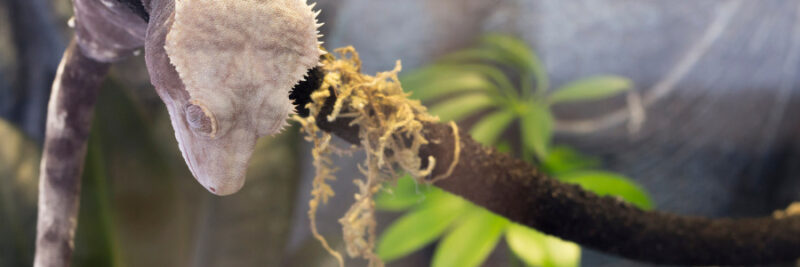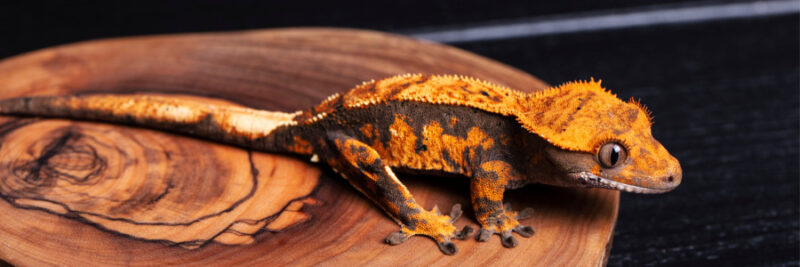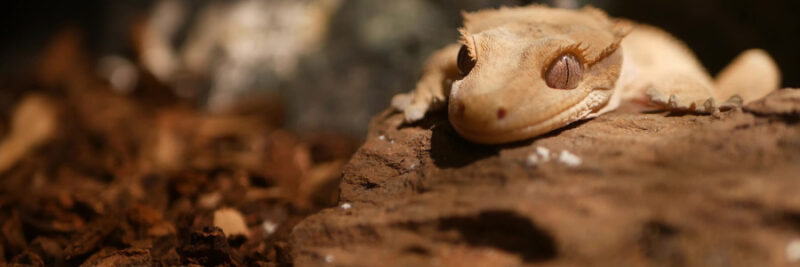
Calling all new gecko keepers – are you seeking the perfect entry point into the wonders of reptile companions? Look no further than the delightful crested gecko! Known for the funky crests adorning their heads and their charming, docile personalities, cresties make ideal starter pets. These fabulous lizards check all the boxes for novice herpers thanks to their hardiness, manageable size, minimal care requirements, and incredible longevity spanning over 20 years.
In this expansive beginner’s guide, we’ll equip you with absolutely everything you need to successfully select, house, feed, handle, and care for a healthy, thriving crested gecko. From constructing simple terrariums to handling techniques, dietary selection, ideal heating parameters, humidity maintenance, enriching their environment, healthcare, and much more – consider this your all-in-one master class in crested gecko companionship! Let’s dive in.
Introduction to Crested Geckos
Hailing from the lush, tropical forests of New Caledonia, an archipelago east of Australia where they live arboreally in tree canopies, crested geckos are small lizards typically measuring between 6 to 8 inches as adults. Their native coloration consists of various tones of red, brown, and grey with a yellowish horizontal bar ringing their eyes. But selective captive breeding over recent decades has produced a hugely expanded spectrum encompassing oranges, yellows, blacks, whites, lavenders, and combinations thereof. Patterns like brindle, pinstripe, tiger, flame, harlequin, and more contribute beautiful unique looks.
While almost purely insectivorous in the wild, crested geckos possess several key adaptations that make them simple to care for in captivity compared to many exotic reptile species. Unlike most lizards which are diurnal and require intense overhead heating and lighting to properly metabolize their food, crested geckos are crepuscular meaning most active during dawn and dusk. They thrive at room temperature without specialized heat sources. Their rooms also require only gentle fluorescent lighting on a day/night cycle vs intense UV lamps. Being non-desert species, they also possess somewhat permeable skin that drinks water through droplets and humidity vs requiring standing water bowls and soaking for hydration.
These qualities coupled with their docile, calm temperaments once settled make them exceptionally popular among children and novice herpers – even apartment dwellers limited on space. Their personalities truly shine through, and they live exceedingly long, which enables deep bonds to form with dedicated owners over decades. Let’s discover proper setup and care for these gems.
Constructing Optimal Enclosures

While active and nimble climbers, most of a crested gecko’s life is spent resting camouflaged against vegetation and branches in rainforest canopies waiting for dusk and dawn periods ideal for hunting. Replicating aspects of their arboreal treetop habitat is key for their health and happiness in our homes. But crested gecko enclosures can be simple compared to expansive custom constructions needed to house larger herps.
Enclosure Selection & Setup
The most essential element is providing enough height for ample climbing room rather than length or width. House adults in tall vivariums around 20 gallons in volume oriented vertically not horizontally. Most juvenile and adult cresties thrive in commercial 18 x 18 x 24 inch or 18 x 18 x 36 inch screen enclosures readily available today. Front-opening doors over 12 inches tall allow easy interior access without needing to dismantle decor. For hatchlings under 6 months, consider starting in plastic 5.5 gallon enclosure to aid humidity retention before upgrading them to adult size.
Furnish the interior with numerous anchored horizontal branches and shelves along with artificial foliage, vines, hammocks and multiple hides allowing feelings of security while resting. Include magnetic ledges and food dishes to minimize dropped feeders. Provide plentiful visually-barriering plants and slanted cork bark walls to satisfy their cryptic nature despite their personable behaviors. Clean, dry substrates are ideal.
Ambient Heating & Lighting Parameters
The magic of crested geckos lies in their adaptability to average household temperatures and gentle lighting schedules. Simply maintaining average room temperatures between 70°F and 80°F suits them perfectly fine without any specialized overhead heating elements like heat lamps. Occasionally, under tank heating mats on thermostats can assist ambient warmth on exceptionally chilly days.
Similarly, bright blazing desert-strength UV lamps are wholly unnecessary. Crested geckos benefit tremendously from exposure to ordinary fluorescent full spectrum tubes producing a gentle glow akin to dappled rainforest canopy sunlight. Position linear T8 or T5 fixtures overlapping just part of the enclosure to create bright and shaded areas. Operate lights on timers to produce 10-14 hours of daytime photoperiods allowing adequate darkness. The beneficial rays synthesized through their skin precludes most D3 and calcium issues common to other lizards.
Humidity Maintenance & Hydration
Given their tropical climate adapting to periodic downpours and dry spells, monitoring and sustaining appropriate humidity ranges is essential for assimilation of proper nutrients through their skin and shedding cycles. Invest in digital gauges to maintain ideal parameters between 50-70% ambient humidity through manually misting enclosures 1-2 times daily to mimic natural rainfall ecology.
Line bottom enclosure floors with 2-3 inches of substrates conducive to trapping and releasing beneficial moisture like orchid bark, sphagnum moss, cypress mulch or organic topsoil mixes. Set under tank heat mats to just one side to offer a humidity hide always 10 degrees warmer than ambient for digesting food. Soak juveniles during lackluster sheds to restore supple skin. While occasional mist licking offers hydration, also provide small shallow water dishes.
Feeding & Nutrition Guidelines
Unlike many purely insectivorous lizards requiring diverse gut loaded live feeds, innovative commercial crested gecko diet recipes make their nutrition simple to balance. But periodic treats keep their lives exciting! Let’s explore suitable edible options.
Balanced Commercial Diets
Specially formulated fruit-flavored powder blends like Repashy and Pangea producing complete balanced nourishment simply require adding water into appetizing shakes. Follow label instructions carefully about keeping refrigerated once mixed for optimum freshness and palatability. While juveniles may lick the formula from dishes directly, mixing food with water encourages more vigorous health.
Live Insects For Variety
Despite commercial diets scientifically meeting all nutritional requirements, adding sporadic low pesticide feeder insects also enriches their quality of life through mental stimulation. Choose size appropriate gut loaded crickets, small dubia roaches, Phoenix worms and mealworms no larger than space between their eyes then monitor feeding response to establish ideal frequencies for individuals ranging 1-2 times weekly. Lightly coat with calcium supplements to offset chitin inhibiting absorption – but avoid oversupplementing commercial diets already incorporating sufficient vitamins and minerals. Vary feeders continually to prevent boredom through these exciting snacks!
Developing Bonds Through Handling

While many new owners wonder if handling shy geckos increases stress, controlled positive gentile interactions actually build critical trust and rapport if performed properly. Always prioritize your gecko’s comfort over your own gratification.
Safe Handling Techniques
Before allowing new geckos to settle into unfamiliar enclosures, refrain from touching them aside from careful bare-hand transfer during first 2 weeks. Then initiate gradual 10-15 minute handling sessions 1-2 times weekly after washing hands without fragrances or lotions that may irritate them when grasping firmly enough to prevent jumping, but delicately sufficiently avoiding compressing their fragile chests. Support entire underside including tail base with both palms to minimize startling launches. Approach slowly with verbal assurances in calm demeanors and avoid overly stimulating environments while handling to inspire eventual comfort and stop seeing you as predators. Confine cats and dogs away from rooms used for interactions.
While many crested geckos learn enjoying interactions and begging to be held, heavy-handed techniques winding or chasing rapidly moving geckos stresses them to the point of escaping by detaching tails that do not regenerate, causing permanent disfigurement and damage. If yours proves exceptionally shy, restrict handling attempts to necessary cage maintenance gloves or arms guards. Protecting their well-being trumps all else.
Relationship Enrichment Inside Enclosures
If acquiring geckos still needing coaxing accepting touch, also focus efforts enriching their daily environments. Watching small movements assures you of their eating and healthy capacities. Installing novel anchored vines, hammocks, magnetic ledges, live plants like Pothos and Ficus and artificial foliage expands adventure without risking impaction from loose substrates if accidentally ingested while hunting prey. Purchase identical hides allowing weekly rotations to break monotony. Occasionally offer approved artificially colored feeder insects to send tongues flicking wildly with excitement through rainbow dinner selections. Placing treats like horns worms or silkworms on feeding ledges nightly forms consistency. Speak gently when entering rooms so your voice indicating treat time masks jarring intrusions. Soon enough they understand your forms as friends through positive repeated exposure rather than threats prompting hiding. Bonding requires profound patience over consistency forming trust through proven actions versus only words.
Maintaining Health & Hygiene

By maintaining meticulous habitats through gentle handling techniques, feeding nutritious balanced diets, interacting patiently allowing adjustments forming affinity and constructing properly heated, humidified and lighted terrariums, common preventable health issues remain at bay so your innocent gecko flourishes. But staying vigilant noticing subtle changes prompting action saves lives.
Recognizing Common Health Issues
Catch developing issues early before they spiral out of control. Monitor daily shedding cycles ensuring properly cued cycles complete rather than accumulating with retained eyecaps and constricting toes. Supplement commercial smoothies with dusted insects if progress stalls. Record weekly photographs noting size and weight gains plateuing may indicate parasites hampering nutrient assimilation requiring fecal analysis to pinpoint solutions restoring vigor.
Since geckos masks symptoms with strong prey drives, look for signs like sunken depressed eye sockets, hollowing hips and tails or fluid buildups indicating organ failure necessitating immediate veterinary interventions, whether husbandry related or genetically predisposed towards certain conditions. Always collect fresh samples to optimize diagnostic testing accuracy. Act decisively, not tomorrow.
Establishing Exotic Pet Veterinary Care
Research qualified exotics veterinary clinics with specialty experience diagnosing and treating geckos long before emergencies strike. Establish patient histories transporting new pets in sterile sealed containers providing initial stool, skin scraping and nail clipping analysis searching for underlying conditions. Discuss supplement alterations, ideal feeding frequencies, lighting and heating parameters geared toward your species and enclosure environments. Follow immunization guidelines as juveniles and adults. Return annually performing wellness checks plus dealing with any trauma, discovering issues preemptively, establishing bonds between animals and doctors – facilitating smoother future emergency treatments fearing the unknowns.
Building reptile health literally relies on committed owners forming trusting patient-doctor relationships supporting one another through inevitable cycles. Assuming financial burdens altruistically provides the highest probabilities living deliciously long prosperous lives deserving warmth and love we all inherently seek. Who knows what adventures await pursuing the yearnings placed inside your soul?
Frequently Asked Questions About Beginner Crested Gecko Care
Focus on a simple habitat with proper stable room temperatures of 70-80°F, gentle handling under supervision to build bonds, 50-70% consistent humidity for hydration and sheds, plus nutritionally balanced commercial diets supplemented with dusted insects following exact label mixing directions to protect their health long-term and establish excellent starter pet skills forming foundations towards advanced herpetology if inspiring further passions.
After allowing at minimum 2 weeks acclimating within enclosures avoiding excess disturbances, prepare initiating handling by thoroughly washing hands first, speaking gently while scooping their entire underside supporting front legs to tails base between both bare palms without compressing chests to minimize startling launches from uncertainty. Move deliberately to build confidence through consistency.
Absolutely - crested geckos are likely the perfect entry species into reptile companionship due to their longevity exceeding 20 years through proper care, diminutive manageable size occupying small vertical display enclosures, predominantly simple care requirements sans intense lighting or heating.
The essential elements include stable ambient room temperatures of 70-80°F to thrive, 50-70% humidity sustained through manual misting regimens for hydration and skin shedding success, opportunities climbing through vertically oriented glass cages and an omnivorous mixed diet of commercial fruit-flavored powdered crested gecko diets mixed with water plus insects like crickets or dubia roaches lightly coated with vitamins as enrichment 1-2 times weekly.
And there you have it – absolutely everything a passionate novice hobbyist needs to fully understand proper husbandry caring for these fabulous starter geckos! Let me know if you have any other beginner questions. We’re wishing you tremendous successes ahead.
